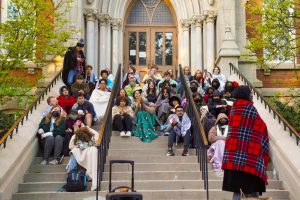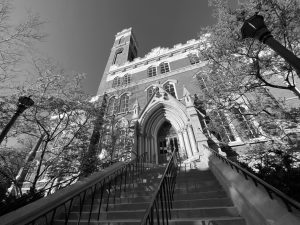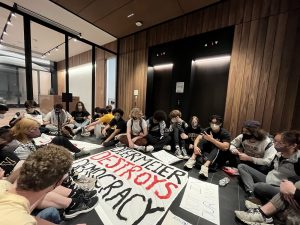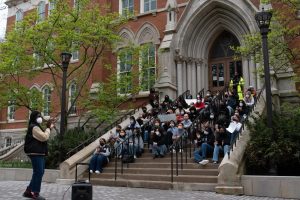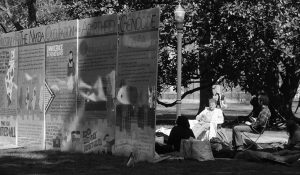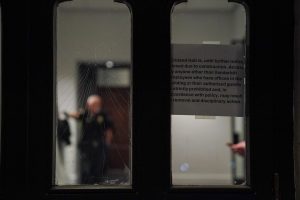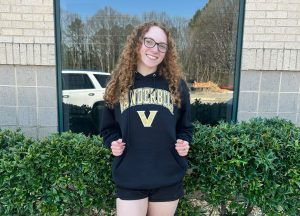Video by Sophie Jeong of VTV News.
In the first 650 miles of his journey across the United States, Chris Andrews listened to the stories of farmers who hadn’t set foot in a grocery store until they were 18 years old, toured a water plant and ate molasses fed to him by a survivalist man who lives in a bunker underground.
When Andrews began to notice that the nature of communication had transformed to become more centered on technology and the impact of this transformation on his own behavior, he set out to learn more about face-to-face interaction. In his research, Andrews discovered that face-to-face interaction is a skill that requires development, and the more society moves away from this skill, the greater the repercussions.
It is the most human and humanizing thing that we do. It is what makes us who we are.
Through studies conducted by Professors Sherry Turkle and Frank Partnoy at MIT and Yale, respectively, Andrews discovered links between face-to-face interaction and patience, empathy and problem-solving skills. Though technology has allowed society to progress, over reliance on technology has also set society back in the realm of person-to-person interaction. For Andrews, these studies strengthened his desire to promote interaction rooted not in technology but in real-life conversations.
“Face-to-face communication is something that brings people together,” Andrews said. “I think that there’s this very abstract consequence, which strikes me daily, which is the friendships, the conversations, the knowledge, and the joy that you don’t even know that you’re missing when you sit on the subway and are on your phone rather than turning to your right and saying ‘hello.’”
Sitting with a former racecar driver turned construction project manager and his artist wife on their front porch as the sun set in Sparta, TN, the three discussed the power of circumstance and coincidence as well as the influence of technology on face-to-face interaction. For the racecar driver, the technological impact on social interaction was a chain of ideas: digital communication as a way of life leads to isolation, isolation leads to ignorance, ignorance leads to fear and fear leads to conflicts.
Before being able to sit down to this conversation about the main ideas of his trip, Andrews must get from place to place along his route each day. Rising between 5 and 6 a.m., he hits the road at 7 a.m., jogging when it is cool in the mornings before stopping for breakfast and continuing on his route. Halfway through the day, when the sun is beating down, he stops at gas stations to interact with the inhabitants of the towns he walks through. Before sundown, he aims to settle into a rhythm in his travel and put in a significant distance before settling just before sundown. He sleeps in a tent on the lawns of strangers whom he has talked to, with their approval. Despite frustration in the journey, Andrews believes that that small setbacks along the way are worth the end result that comes with face-to-face interaction.
“Little bursts of frustration normally happen when I’m on the road: it’s over 100 degrees, there’s no shoulder on the road, I’m going up a mountain, and it starts thunderstorming. … But at the same time, that is what gives me energy — when I put myself out there, and I am rewarded in a way by having these really great conversations. I’m energized by that.”
Mind filled with the story of a South Carolina farmer dressed in overalls and living by a lake who sat down to talk to him outside his tent at night, with the image of a group of mountain people roasting a 500-pound mountain hog outside a fire station, and with the reunion with familiar faces in Nashville, Chris now begins the next leg of his journey, which will eventually take him to Southern California.
The only material objects with him are the contents of the cart he pushes: a tent, water, food, clothing, medical equipment and a stove. But along with those physical objects and with those memories, he carries his intention to promote face-to-face interaction in every city he visits.
By all means, use technology, use it for what it is: a great tool.
“It is the most human and humanizing thing that we do. It is what makes us who we are, and it is the greatest catalyst for growth as an individual and as a community,” Andrews said. “It’s the centerpiece of our daily lives. … I hope to just start the conversation and hope that the conversation starts to move the needle on the way we perceive the value of face-to-face conversation. … By all means, use technology, use it for what it is: a great tool. You don’t have to unplug, you can be comfortable with that, but just understand that this is a question of quality of life. If you can learn how to strike that balance and work that into your routine, then I think that we all have a lot to gain from that.”


